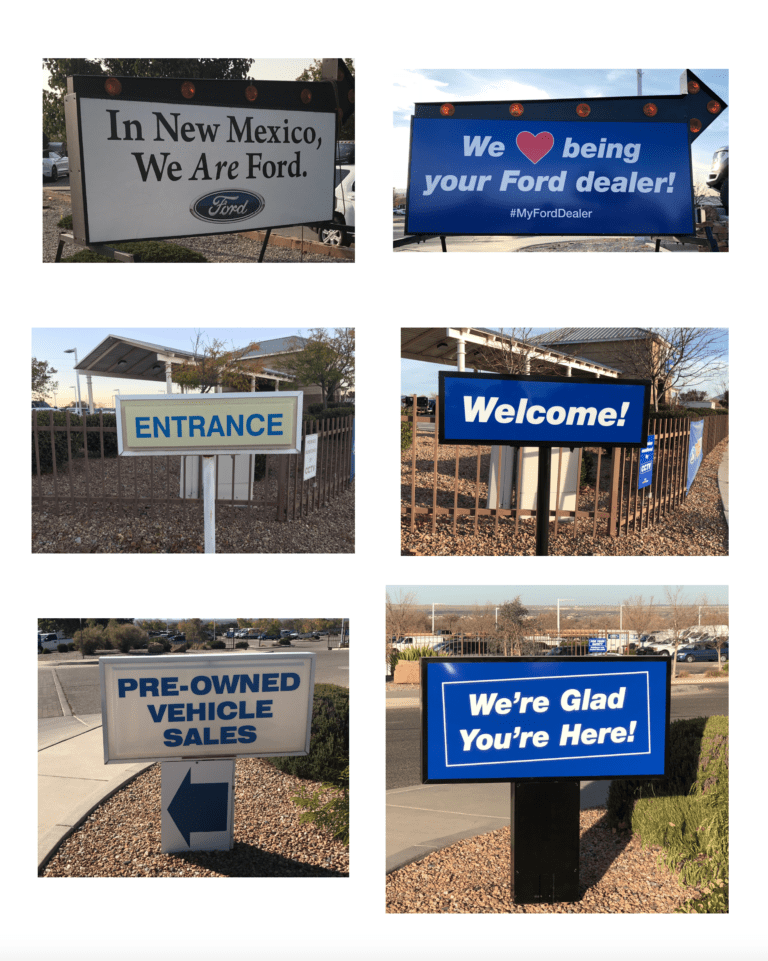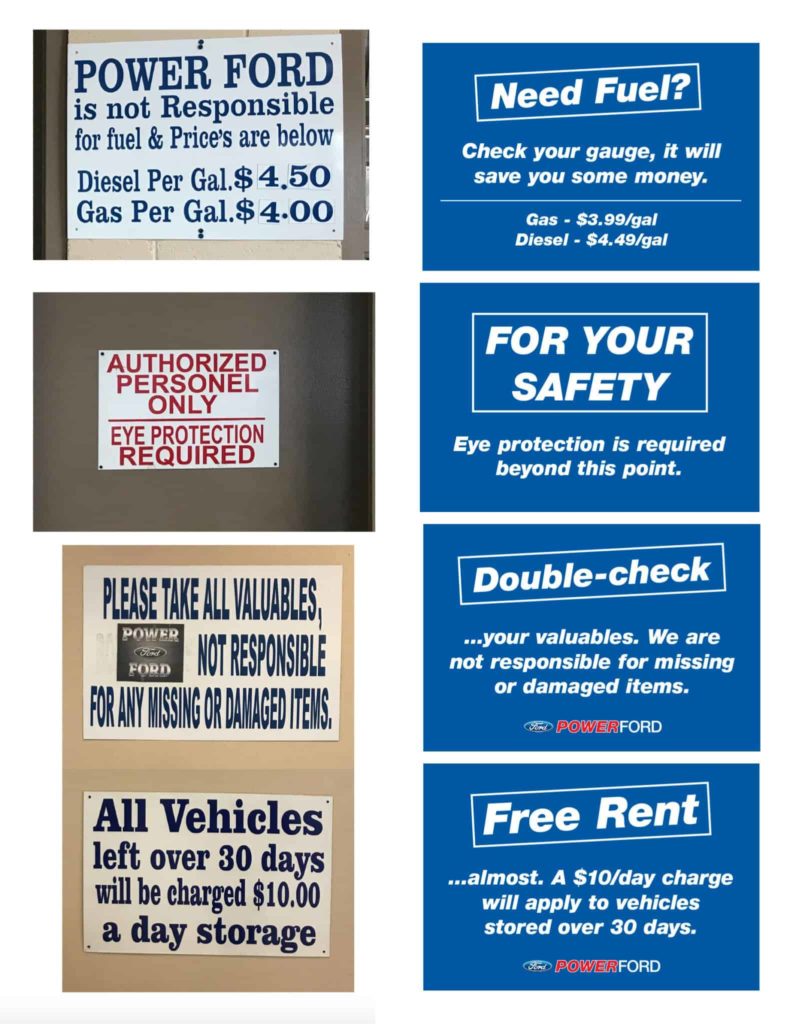Last week, we shared the first part of a three-part guide for improving the dealership experience. In that first part, we talked about how the Power Ford team transformed their customer experience and improved their brand reputation.
Now, we’re excited to share part two, which is full of more helpful tips from the Power Ford team.
Tip #3: Make sure your online experience matches your in-store experience.
Once Power Ford reimagined their branding and their online reputation, they started looking internally at their in-person dealership experience to see if it aligned. Spoiler alert: It didn’t. “We really wanted to ease the anxiety of going to a car dealership,” said Matt. “It should be a fun experience to purchase a new car—not one to dread!” So Matt quickly put his background in consumer experience to work and Power Ford implemented several key changes inside their dealership:
→ Created a world-class hospitality area.
Instead of having a “waiting area,” for customers, where the connotation of the word “waiting” is enough to depress you, Power Ford flipped the script and created a “Guest Lounge,” complete with all the things that could make customers or their families comfortable while at the dealership. The Guest Lounge offers complimentary Starbucks coffee, comfortable seating, snacks, and more. “Is this an investment, yes,” said Matt. “But there is ROI in terms of our CSI and gross margins. It seems like some dealers feel they don’t have to do this because business is good, but they don’t realize how important it really is.”
→ Changed the ambiance.
At first, all the walls in the dealership were white. “It didn’t portray a warm and inviting feeling,” said Matt. “So we painted the showroom with more friendly, comfortable colors and put large canvas images in the hallways and offices.” They chose lifestyle images with happy people smiling to create a more inviting atmosphere. “80% are just happy people,” said Matt. “20% are cars. The idea is to show people at different stages of life, sending the subliminal message to our customers that this could be them. It helps them think about how their new car will help tell their story.”

→ Rolled out the red carpet—literally.
In an effort to make the car-buying experience more fun for their guests, Power Ford rolled out a red carpet so their customers can take pictures and feel like celebrating when they buy a new car. A small change that makes a big difference.

→ Updated their uniforms.
Have you ever gone to Target and asked someone in a red shirt for help, but found out they weren’t actually an employee? It happens all the time! When buyers go to Target, they know the people in the red polos are the people they can go to for help. At Power Ford, they wanted that kind of clarity for their guests as well. So they got new uniforms for everyone so customers know exactly who they can go to when they have a question.
→ Changed all their signage.
When Matt first started looking at the signage inside and around the dealership, he was surprised by what he saw. There were signs like, “Do not enter, employees only,” or “Violators will be prosecuted.” This type of language was not customer-centric, nor was it any kind of inviting. “Look at your signage,” said Matt. “The language you use on those signs can change everything. Use words like ‘welcome’ instead of ‘entrance.’ Or ‘complimentary’ in place of ‘free.’” Here are some great examples of signs Power Ford changed:


When it comes to creating a welcoming, warm ambiance and an excellent dealership experience, “every detail matters,” said Matt.
Tip #4: Ask customers for feedback—and then do something with it.
Of course, none of the changes you make in your dealership will matter if they don’t actually improve your customer experience. But how do you keep tabs on customer sentiment? Well, you actively ask them for feedback. In OEM dealerships, however, the manufacturer sends out their own Customer Satisfaction Index (CSI) survey, so the challenge is finding a way to ask for feedback that doesn’t feel duplicative to the CSI survey. Here’s what Power Ford does:
→ Send a next-morning text message asking for a review.
“Our SMS system integrates with our dealer management system (DMS),” said Matt, “So every time we close a sale or an RO, that customer gets a text message the next morning that says, ‘On a scale of one to five, how was your experience?’ Once they respond, we send a follow-up text that says, ‘Thank you! Click on the link below to leave us a review.’” Once they implemented these follow-up texts asking for feedback and a review, their review collection rate increased dramatically and their overall star rating and CSI scores went up.
→ Read and respond to reviews quickly.
Reviews can be a very informative tool, especially if you have someone reading every review that comes in, taking the time to respond, and documenting the feedback. Particularly if you receive a negative review, a quick response can help you resolve issues before the OEM CSI survey goes out, which will help your CSI scores overall. “Inevitably,” said Matt, “Those are some of the biggest raving fans—when they’ve had a less than good experience, and then someone reaches out to them and shows empathy and says, ‘Hey, we made a mistake. Here’s how we can fix it.’ Customers appreciate the transparency. It’s one of my favorite things to do.”
Tip #5: Do what you say you will do—communication is key.
“If you tell someone you will call them back, do it,” said Matt. He could not stress enough the need for dealerships to over-communicate with customers. And not just that, but also to make it as easy as possible for customers to receive your communication and to communicate with you. Here are a few key ways Power Ford has up-leveled their customer communication and seen fantastic results:
→ Implemented a text-message-based live chat solution.
One of the first things Matt did when he joined Power Ford was look into their website experience in terms of its effectiveness in driving leads. He looked at several different options and every sign pointed back to adding a live chat box to their website. “I didn’t necessarily like that option,” said Matt, “Because a lot of the time, people are on their mobile phones when they look at your website, and having a live chat pop up interrupts the experience and then if you get a phone call and have to go back to the chat, your chat is gone or over. It’s not a great user experience.”
So Matt and his team set out to find a solution that would eliminate the friction involved in the live chat experience. “Podium’s text messaging platform did exactly that,” said Matt. “On the website, when people click the Podium logo at the bottom, a chat box pops up. And it says, ‘We’ll text you shortly.’ The customer puts in their name, their phone number, and then instantly we receive that lead as a business, and the customer gets a text message. It’s a much better experience.”
Doing this, Matt said, helped their lead response times go down to under two minutes—increasing the number of lead conversions for Power Ford, and providing a better experience for customers overall.
→ Focused on having quicker response times.
“Response times are important for any business,” said Matt. One of the things Power Ford discovered quickly was they needed a better way to eliminate communication friction for their customers and provide them with the information they need to make the best buying decision as fast as possible.
“When a customer messages in and has to wait for five or ten minutes for a response,” said Matt, “It’s not a good experience. The longer they wait, the more they start to feel ignored. And the more likely they are to go to a competitor who responds faster.”
→ Consolidated messaging leads into a single inbox.
“When you have leads coming in from Facebook, your website, voicemails, and so on,” said Matt, “You have four or five different windows up on your computer and things inevitably fall through the cracks.” And when dealerships have leads fall through the cracks, that can represent thousands of dollars in sales lost. So Power Ford implemented a text-message-based marketing and communication platform that helps them keep track of every lead across channels like their live chat, social media, missed calls, and more.
“When you have a team of people looking at those messages, no customer goes unanswered,” said Matt. “Anybody can respond, and no customers get ignored, which makes them feel valued.”
→ Found a way to keep customers updated without playing phone tag.
Originally, the service advisors at Power Ford spent a lot of their day answering phones or calling customers to give them updates on their vehicles—and it wasted a lot of time. So, Matt found a way to streamline the communications needed to save time for the service department and provide a better experience for customers—text messaging.
“Every time a customer visits our service department and starts a repair order, they instantly receive a text message welcoming them to Power Ford,” said Matt. “This easily informs them that a text message is the best way to communicate, and that is a great thing.” This makes it easy for customers to respond with questions. It also makes it possible for advisors to quickly send updates without having to pick up the phone and have a 5-10 minute conversation.
“We’ve seen a notable decrease in inbound phone calls for our service advisors,” said Matt. “Communication is vital to our business, and phone calls are not bad. But what we’ve seen with text messages is that our team is more proactive in their communication which our customers appreciate.” According to Matt, using text messaging helps reduce the anxiety a customer may feel waiting for an update while helping service advisors communicate and work more efficiently.
Loved the first two parts of this three-part guide? Keep an eye out for part three, coming to the Podium blog next week.


